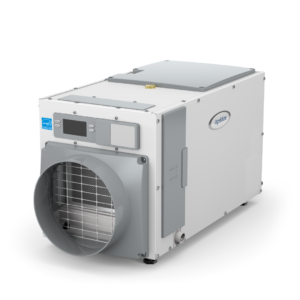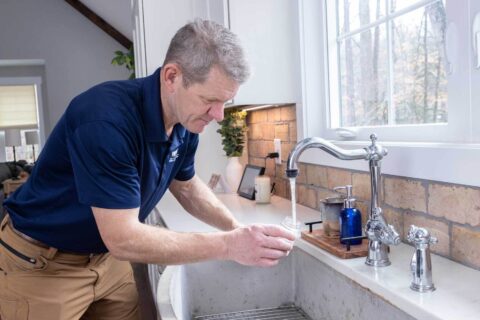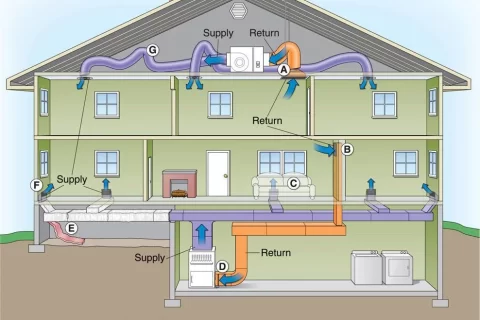Do Dehumidifiers Reduce Mold Growth?
Mold can be a nightmare in any home. It thrives in damp spaces, making dehumidifier mold prevention essential for a healthy living environment. A dehumidifier helps reduce humidity levels and keeps your space dry. This not only protects your walls and furniture but also improves air quality with humidifiers and a home dehumidifier to help prevent dehumidifier mold.
Understanding how to effectively use a dehumidifier can save you from costly repairs and health issues caused by mold exposure. This post will guide you through the best practices for mold prevention using a dehumidifier. You’ll learn tips to optimize its performance with a humidifier and maintain a mold-free home.
Key Takeaways
-
Keep indoor humidity levels below 50% to prevent mold growth; using a dehumidifier can help maintain this level effectively.
-
Regularly check and clean your dehumidifier to ensure it operates efficiently and continues to remove moisture from the air.
-
Understand that while dehumidifiers can reduce mold spores, they do not eliminate existing mold; proper cleaning is still necessary.
-
Choose a dehumidifier with the right capacity for your space to maximize its effectiveness in controlling humidity and preventing mold.
-
Look for signs of effective dehumidification, such as reduced musty odors and dry surfaces, to confirm your device is working properly.
-
Combine dehumidifier use with other mold prevention strategies, like proper ventilation and regular inspections, for best results.
Understanding Humidity and Mold
Defining Humidity
Humidity refers to the amount of moisture present in the air. It is measured as a percentage, known as relative humidity, which can affect dehumidifier mold. A higher percentage indicates more moisture in the air. This excess moisture creates a perfect environment for mold growth. Mold thrives in damp areas, making it crucial to monitor indoor humidity levels.
Optimal indoor humidity levels typically range from 30% to 50%. When humidity exceeds this range, it can lead to problems. High humidity can cause discomfort and health issues. It can also damage property, promote the growth of airborne mold, and require a humidifier.
High Humidity Levels and Mold Growth
High humidity levels significantly increase the likelihood of mold infestations. Mold spores are always present in the air. They become active when they find a suitable environment with excess moisture. Studies show that mold can grow within 24 to 48 hours in high humidity conditions, especially when a humidifier is used.
Mold can affect indoor air quality. It releases allergens and irritants, including dehumidifier mold, that may trigger respiratory issues. People with asthma or allergies are particularly vulnerable. Keeping indoor humidity low helps prevent these health risks.
Sources of Indoor Humidity
Common sources of excess humidity include cooking, bathing, and weather conditions. Cooking generates steam, which raises moisture levels indoors. Bathing also contributes to increased humidity, especially without proper ventilation, similar to a humidifier.
Weather plays a significant role too. Rainy days can lead to higher indoor moisture levels if homes are not well-sealed. Even seasonal changes affect humidity levels. For instance, summer often brings high humidity, while winter may lead to low humidity indoors, making a humidifier useful.
Other sources include houseplants and poorly insulated walls. They can trap moisture inside homes, creating a humid environment conducive to mold growth, similar to a humidifier.
Monitoring Humidity Levels
Regular humidity testing is essential in maintaining optimal indoor conditions. Homeowners should use hygrometers to check humidity levels frequently. If readings exceed 50%, steps such as using a humidifier must be taken to reduce moisture.
Dehumidifiers are effective tools for managing excess humidity. They help extract moisture from the air, as a humidifier, lowering humidity levels effectively. Proper ventilation is also vital in controlling indoor moisture.

How Dehumidifiers Work
Mechanical Dehumidifiers
Mechanical dehumidifiers use a fan to draw in humid air. The air passes over cold coils inside the unit. As the air cools, water vapor condenses into liquid water. This process is similar to how dew forms on grass in the morning.
The condensed water collects in a tank or drains away through a hose. This method effectively reduces humidity levels in indoor spaces. It helps prevent mold growth by keeping moisture levels low.
Dehumidifying Systems
Dehumidifying systems can vary in design but function similarly. These systems often include built-in fans and filters. They work continuously to maintain a set humidity level.
Most systems have a hygrometer that measures humidity. When humidity rises above the desired level, the system activates automatically. This ensures consistent moisture control throughout the home.
Regular maintenance of these systems is crucial. Cleaning the filters keeps the air quality high. It also allows the system to operate efficiently.
Desiccant Dehumidification
Desiccant dehumidification is another method for moisture removal. This type uses materials that absorb moisture from the air. Common desiccants include silica gel and activated alumina.
These units do not rely on cooling to remove moisture. Instead, they pull humid air through a desiccant material, which captures water vapor. The dried air then circulates back into the room.
Desiccant dehumidifiers are effective in colder climates. They work well when temperatures drop below what mechanical units can handle.
Importance of Cooling Air
Cooling air is essential for effective moisture removal. As warm air cools, its capacity to hold moisture decreases. This leads to condensation, which is crucial for extracting humidity from indoor spaces.
By lowering the temperature of the air, dehumidifiers create an environment where water vapor can easily condense. This process directly impacts how well they reduce humidity levels.
Maintaining Indoor Climate
Dehumidifiers play a significant role in maintaining a comfortable indoor climate. They help regulate humidity levels, making spaces feel cooler and more comfortable during hot weather.
Lower humidity also improves air quality. It reduces allergens like dust mites and mold spores, contributing to better health outcomes for residents. A balanced indoor environment promotes comfort and well-being.
Do Dehumidifiers Remove Mold
Prevention Role
Dehumidifiers play a key role in mold prevention. They reduce humidity levels in the air. High humidity creates a perfect environment for mold to thrive. However, a dehumidifier does not eliminate existing mold. It only helps prevent new growth.
Existing Mold
Removing existing mold is crucial before using a dehumidifier. Mold spores can linger on surfaces even when humidity decreases. Cleaning these surfaces is necessary to stop mold from spreading. Use appropriate cleaning solutions to remove visible mold. After cleaning, the dehumidifier can help maintain lower humidity levels.
Dormant Spores
Mold spores can remain dormant under certain conditions. They may lie inactive when humidity is low. Once humidity rises again, these spores can reactivate and grow. This process happens quickly, often within 24 to 48 hours. Keeping humidity below 50% helps prevent this reactivation.
Ideal Conditions
Mold prefers specific conditions to grow. Warmth and moisture create an ideal environment. Areas like bathrooms, kitchens, and basements often have higher humidity. These spaces are common breeding grounds for mold. Regularly using a dehumidifier in these areas helps keep moisture levels down.
Maintenance Tips
To effectively use a dehumidifier for mold prevention, consider these tips:
-
Set the right humidity level: Aim for 30-50% relative humidity.
-
Regularly empty the tank: A full tank can lead to increased humidity.
-
Clean the unit: Dust and dirt can affect its efficiency.
-
Monitor humidity levels: Use a hygrometer to track changes.
Following these steps ensures the dehumidifier functions effectively.
Benefits of Using Dehumidifiers
Health Advantages
Dehumidifiers provide significant health benefits. They reduce humidity levels in the air. This reduction leads to fewer allergens like mold and dust mites. High humidity often worsens allergy symptoms. With less moisture, people experience fewer respiratory issues.
Studies show that maintaining indoor humidity below 50% can lower the risk of asthma attacks. It also helps prevent the growth of harmful bacteria. A clean environment promotes better overall health.
Home Protection
Using dehumidifiers protects your home and belongings. Excess moisture can damage wooden structures. It causes wood to warp and rot over time. This damage can lead to costly repairs.
Mold growth thrives in damp conditions. By controlling humidity, you prevent mold from forming on walls and ceilings. This protection extends to personal items too. Books, electronics, and clothing benefit from a drier environment.
Energy Savings
Dehumidifiers can lead to energy savings. Lower humidity levels make your home feel cooler. This means you may not need to run your air conditioner as much. Consequently, this results in reduced cooling costs.
According to the Department of Energy, using a dehumidifier can lower energy bills by up to 15%. This is especially true during hot summer months when humidity rises. Investing in a dehumidifier pays off through these savings.
Dehumidifier Cleaning Tablets
Regular maintenance is crucial for dehumidifiers to work effectively. Using dehumidifier cleaning tablets helps keep them running well. These tablets break down mineral buildup inside the unit. This ensures optimal performance and longevity of the appliance.
Cleaning your dehumidifier every few months enhances its efficiency. It also prevents unpleasant odors caused by stagnant water. A well-maintained unit will provide better results in reducing humidity.
Comparison with Humidifiers
Humidifiers add moisture to the air, which is beneficial in dry climates. However, using a humidifier in a damp environment can worsen mold issues. Understanding when to use each device is essential for maintaining a healthy home atmosphere.
In summary, dehumidifiers play a vital role in mold prevention and overall health improvement. They offer various benefits such as enhanced air quality, protection against structural damage, and potential energy savings. Regular cleaning ensures they operate efficiently, providing a comfortable living space.
Choosing the Right Dehumidifier
Assess Humidity Levels
Humidity levels vary by location. Knowing the specific humidity in your area helps you choose the right dehumidifier. For example, regions with high humidity may need a commercial dehumidifier with a larger capacity. These units can handle more moisture. A home dehumidifier is suitable for standard indoor environments.
Monitor your indoor humidity levels regularly. Use a hygrometer to check the readings. Ideally, indoor humidity should stay between 30% and 50%. If it exceeds this range, consider investing in a desiccant dehumidifier or an electronic dehumidifier. Both options effectively reduce moisture.
Placement Matters
Placement of your dehumidifier affects its efficiency. Put it in areas with high humidity, like basements and bathrooms. These spaces often trap moisture and promote mold growth. A refrigerant dehumidifier works best in these conditions.
Ensure that air can circulate around the unit. Avoid placing it against walls or furniture. This allows the dehumidifier to pull in moist air efficiently. Some people prefer absorption dehumidifiers for smaller spaces. They are quieter and consume less energy.
Regular Maintenance
Regular maintenance is crucial for optimal performance. Clean your dehumidifier unit every few weeks. Dust and dirt can block airflow and reduce effectiveness.
Check the water collection tank frequently. Empty it when full to prevent overflow and mold growth. Some models have continuous drainage options to simplify this process.
Replace filters as needed. Clogged filters can lead to poor performance and unhealthy air quality. Following manufacturer guidelines ensures longevity for your refrigerative dehumidifiers.
Consider how much you are willing to spend on a dehumidifier. An expensive dehumidifier may offer advanced features but might not be necessary for every household. Evaluate your needs before making a purchase decision.
Signs of Effective Dehumidification
Reduced Condensation
Condensation on windows is a clear sign of high humidity. When humidity levels drop, you will notice less moisture collecting on glass surfaces. This change means the dehumidifier is working well. Less condensation helps prevent mold growth. Mold thrives in damp conditions. By reducing moisture, you create an environment that is less favorable for mold.
Decreased Musty Odors
Musty odors often indicate excess humidity. A strong smell can signal that mold or mildew is present. After effective dehumidification, these odors should lessen significantly. Improved air quality leads to a fresher environment. Regularly checking for smells can help you assess the effectiveness of your dehumidifier. If you notice fewer musty scents, it shows that humidity control is improving.
Enhanced Comfort Levels
Comfort levels in a space can change with humidity management. High humidity makes rooms feel sticky and uncomfortable. You will likely feel cooler and more comfortable when humidity decreases. This improvement indicates that the dehumidifier is effectively removing excess moisture from the air. People often report feeling better overall when humidity levels are controlled.
Monitoring Humidity Levels
Using a hygrometer can help track indoor humidity levels. Ideal indoor humidity ranges from 30% to 50%. Keeping an eye on these numbers allows you to know if your dehumidifier is doing its job. If readings stay within this range, it suggests effective dehumidification.
Visible Changes in Space
Look for visible changes in your living space as well. Walls and ceilings should remain dry without signs of water damage or staining. Paint should not peel or bubble due to moisture. These signs show that your dehumidifier is maintaining proper humidity levels.
Maintenance Checks
Regular maintenance of your dehumidifier also plays a role in effectiveness. Clean the filter and empty the water reservoir as needed. A well-maintained unit operates more efficiently. This efficiency directly impacts how well it controls moisture.
Energy Efficiency
An effective dehumidifier can also save energy costs. When it runs smoothly, it uses less power to maintain ideal humidity levels. Look for models with energy-efficient ratings to ensure long-term savings.
Additional Mold Control Tips
Routine Inspections
Regular inspections can help detect mold problems early. Focus on areas prone to moisture, like basements and bathrooms. Check for leaks or water damage. Look for signs of mold growth on walls and ceilings. Inspect under sinks and around appliances too.
These checks should happen at least once a month. Early detection can prevent serious mold issues later. If you find any mold, take action quickly. Remove it promptly to avoid further spread.
Proper Ventilation
Proper ventilation is vital in preventing mold growth. Use exhaust fans in kitchens and bathrooms to reduce humidity levels. Open windows when weather allows to let fresh air circulate. This helps decrease airborne mold spores indoors.
Dehumidifiers work effectively but need support from good airflow. Keep interior doors open to allow air movement between rooms. This practice helps maintain consistent humidity throughout the house.
Mold-Resistant Materials
Using mold-resistant materials during construction or renovations can significantly reduce future problems. Consider using mold-resistant drywall and paint in moisture-prone areas. These products contain additives that inhibit mold growth.
Choose flooring materials that resist moisture, such as tile or vinyl. Avoid carpets in basements or other damp areas, as they can trap moisture and promote growth. Investing in these materials now can save time and money on mold removal later.
Addressing Leaks Promptly
Leaks can lead to serious mold infestations if not addressed quickly. Fix any plumbing issues as soon as they arise. Inspect roofs and gutters regularly to prevent water damage from leaks.
If you notice water pooling around your home’s foundation, take action immediately. Water can seep into walls and create an environment for mold spores to thrive.
Educating Household Members
Educating everyone in the house about mold prevention is essential. Teach them about the importance of keeping areas dry and clean. Encourage them to report any signs of moisture or leaks.
Create a checklist of tasks for family members to follow, such as checking vents and cleaning humid areas regularly. Awareness can lead to proactive measures against potential mold issues.
Closing Thoughts
Preventing mold is crucial for your health and home. Using a dehumidifier effectively reduces humidity levels, making it harder for mold to thrive. You’ve learned how these devices work and the benefits they bring. Choosing the right one tailored to your needs can make all the difference in keeping your space dry and mold-free.
Don’t stop here. Combine dehumidification with other mold control tips for maximum protection. Regular maintenance and monitoring humidity levels are key. Take action now to safeguard your environment and enjoy a healthier living space. Your well-being depends on it.
Frequently Asked Questions
What humidity level prevents mold growth?
Maintaining indoor humidity levels between 30% and 50% helps prevent mold growth. Use a hygrometer to monitor humidity regularly.
Can dehumidifiers eliminate existing mold?
Dehumidifiers do not remove existing mold. They reduce moisture, creating an environment less conducive to mold growth. Cleaning visible mold is still necessary.
How often should I run my dehumidifier?
Run your dehumidifier continuously in humid conditions or until the desired humidity level is reached. Regular use ensures effective moisture control.
Are all dehumidifiers effective for mold prevention?
Not all dehumidifiers are equal. Choose one with adequate capacity for your space and features like auto shut-off and continuous drainage for optimal results.
How do I know if my dehumidifier is working?
Signs include reduced humidity levels, decreased musty odors, and dry surfaces. A built-in hygrometer can help you monitor effectiveness.
Can I use a dehumidifier in any room?
Yes, but focus on areas prone to dampness, like basements, bathrooms, and kitchens. Proper placement enhances efficiency in mold prevention.
What additional measures can I take against mold?
In addition to using a dehumidifier, ensure proper ventilation, fix leaks, and clean spills promptly. Regular maintenance will further reduce mold risks.


